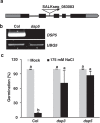AtPFA-DSP5 interacts with MPK3/MPK6 and negatively regulates plant salt responses
- PMID: 34839796
- PMCID: PMC9208770
- DOI: 10.1080/15592324.2021.2000808
AtPFA-DSP5 interacts with MPK3/MPK6 and negatively regulates plant salt responses
Abstract
Protein tyrosine phosphatases play essential roles in plant growth and development and in plant responses to biotic or abiotic stresses. We recently demonstrated that an atypical dual-specificity protein tyrosine phosphatase in plants, AtPFA-DSP3 (DSP3), negatively regulates plant salt tolerance. Here, we report that a homolog of DSP3, AtPFA-DSP5 (DSP5), affects the response of plants to high-salt conditions. A loss-of-function mutant of DSP5 showed reduced sensitivity to salt treatment at the seed germination and vegetative stages of development while a gain-of-function mutant of DSP5 showed increased sensitivity to salt stress. The salt responses of dsp3dsp5 double-mutant plants were similar to those of dsp3 and dsp5 single-mutant plants. Gel overlay and firefly luciferase complementation assays showed that DSP5 interacts with MPK3 and MPK6 in vitro and in vivo. These results indicate that DSP5 is a novel negative regulator of salt responses in Arabidopsis that interacts directly with MPK3 and MPK6.
Keywords: Arabidopsis; AtPFA-DSP5; protein tyrosine phosphatase; salt stress.
Conflict of interest statement
No potential conflict of interest was reported by the author(s).
Figures
Similar articles
-
AtPFA-DSP3, an atypical dual-specificity protein tyrosine phosphatase, affects salt stress response by modulating MPK3 and MPK6 activity.Plant Cell Environ. 2021 May;44(5):1534-1548. doi: 10.1111/pce.14002. Epub 2021 Feb 15. Plant Cell Environ. 2021. PMID: 33464564
-
MAPK phosphatase MKP2 mediates disease responses in Arabidopsis and functionally interacts with MPK3 and MPK6.Plant J. 2010 Sep;63(6):1017-30. doi: 10.1111/j.1365-313X.2010.04297.x. Plant J. 2010. PMID: 20626661
-
The heat shock factor A4A confers salt tolerance and is regulated by oxidative stress and the mitogen-activated protein kinases MPK3 and MPK6.Plant Physiol. 2014 May;165(1):319-34. doi: 10.1104/pp.114.237891. Epub 2014 Mar 27. Plant Physiol. 2014. PMID: 24676858 Free PMC article.
-
Mild osmotic stress promotes 4-methoxy indolyl-3-methyl glucosinolate biosynthesis mediated by the MKK9-MPK3/MPK6 cascade in Arabidopsis.Plant Cell Rep. 2017 Apr;36(4):543-555. doi: 10.1007/s00299-017-2101-8. Epub 2017 Feb 2. Plant Cell Rep. 2017. PMID: 28155113
-
The cell biology of primary cell walls during salt stress.Plant Cell. 2023 Jan 2;35(1):201-217. doi: 10.1093/plcell/koac292. Plant Cell. 2023. PMID: 36149287 Free PMC article. Review.
Cited by
-
Genome-wide identification and analysis of abiotic stress responsiveness of the mitogen-activated protein kinase gene family in Medicago sativa L.BMC Plant Biol. 2024 Aug 24;24(1):800. doi: 10.1186/s12870-024-05524-4. BMC Plant Biol. 2024. PMID: 39179986 Free PMC article.
References
Publication types
MeSH terms
Substances
Grants and funding
LinkOut - more resources
Full Text Sources
Other Literature Sources
Molecular Biology Databases




